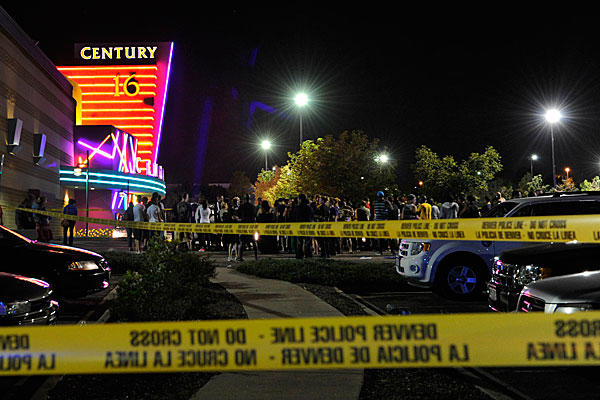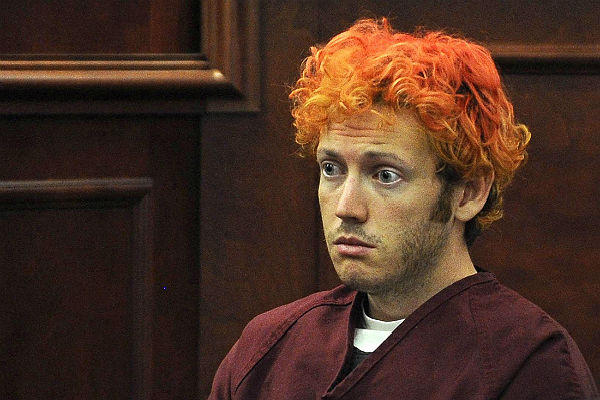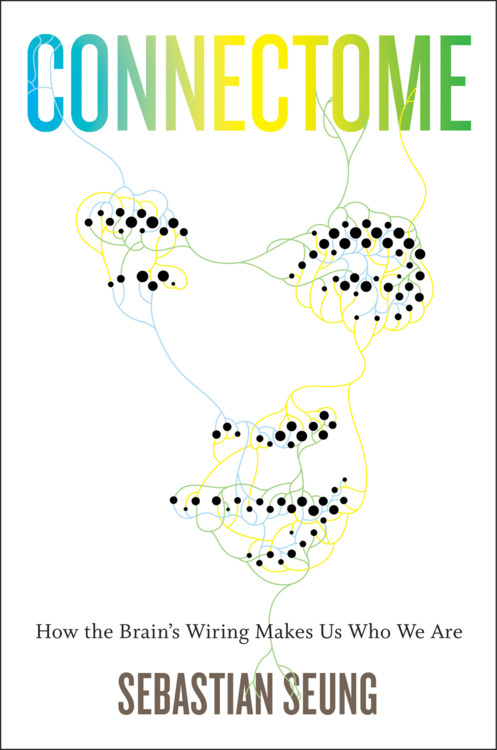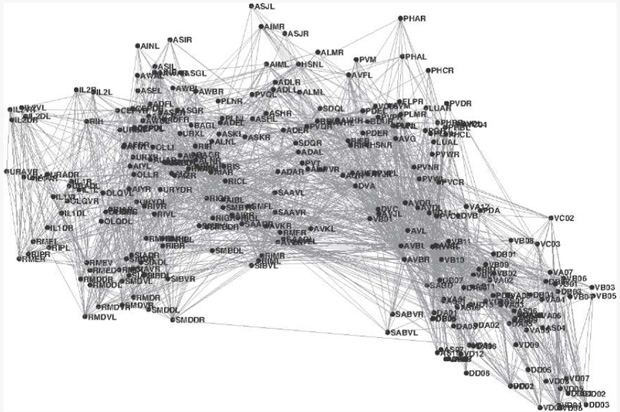Colorado Batman Shooting Shows Obvious Signs of Being Staged
worldtruth.tv | Jul 20th 2012
James Holmes, the Aurora, Colorado shooter who reportedly opened fire at a Batman movie premiere, was a medical student at the University of Colorado, pursuing a PhD in neuroscience, reports ABC News. (http://abcnews.go.com/US/mass-shooting-colorado-movie-theater-14-peop…)
As part of the attack, Holmes painted his hair red and referred to himself as “The Joker,” one of the arch enemies in the DC Comics-inspired Batman movie series. ()
According to news reports, this sudden violent rampage was completely out of character for James Holmes, who was described as “shy.”
The New York Times is now reporting:
Billy Kromka, a pre-med student at the University of Colorado, Boulder, worked with Mr. Holmes for three months last summer as a research assistant in a lab of at the Anschutz Medical Campus. Mr. Kromka said he was surprised to learn Mr. Holmes was the shooting suspect. “It was just shocking, because there was no way I thought he could have the capacity to do commit an atrocity like this,” he said. (http://www.nytimes.com/2012/07/21/us/colorado-mall-shooting.html?page…)
“He spent much of his time immersed in the computer, often participating in role-playing online games…”
There is already conjecture that James Holmes may have been involved in mind-altering neuroscience research and ended up becoming involved at a depth he never anticipated. His actions clearly show a strange detachment from reality, indicating he was not in his right mind. That can only typically be accomplished through drugs, hypnosis or trauma (and sometimes all three).

His behavior doesn’t add up
His behavior already reveals stark inconsistencies that question the mainstream explanation of events. For example, he opened fire on innocent people but then calmly surrendered to police without resistance. This is not consistent with the idea of “killing everyone.”
Furthermore, he then admitted to police that his apartment was booby-trapped with explosives. If you were really an evil-minded Joker trying to kill people (including cops), why would you warn them about the booby trap in advance? It doesn’t add up.
“Holmes was taken into custody shortly after the shooting, police said, adding he didn’t resist when he was arrested,” reports a local CBS news affiliate (http://newyork.cbslocal.com/2012/07/20/police-14-dead-in-colorado-the…).
“After his arrest, Holmes told police about ‘possible explosives in his residence,’ Oates said. When police searched his apartment, they discovered it was booby-trapped and evacuated surrounding buildings, police said. Oates said bomb technicians are determining how to disarm flammable or explosive material in the third-floor apartment. He said police could be there some time.”
None of this checks out. If you’re a killer bent on causing mayhem, why tell the police about your surprise bomb waiting for them back at your apartment?
Holmes was clearly provided with exotic gear
Continuing from CBS:
“He said pictures from inside the apartment are fairly disturbing and the devices look to be sophisticated, adding the booby-traps were ‘something I’ve never seen.’ One rifle, two handguns, a knife, a bullet proof vest, a ballistic helmet, a gas device, a gas mask, military SWAT clothing and unidentified explosives were also found in Holmes’ car, a law enforcement source told CBS News. Oates said Holmes wore a gas mask, a ballistic helmet and vest as well as leg, groin and throat protectors during the shooting.”
In other words, this guy was equipped with exotic gear by someone with connections to military equipment. SWAT clothing, explosives, complex booby-traps… c’mon, this isn’t a “lone gunman.” This is somebody who was selected for a mission, given equipment to carry it out, then somehow brainwashed into getting it done.
“Aurora Police Chief Dan Oates said Holmes’ apartment is booby-trapped with a ‘sophisticated’ maze of flammable devices. It could take hours or days for authorities to disarm it,” reports Yahoo News (http://sg.sports.yahoo.com/blogs/lookout/suspect-neuroscience-phd-stu…).
This is not your run-of-the-mill crime of passion. It was a carefully planned, heavily funded and technically advanced attack. Who might be behind all this? The FBI, of course, which has a long history of setting up and staging similar attacks, then stopping them right before they happen. See four documented stories on these facts:
http://www.naturalnews.com/035849_domestic_terror_plots_FBI.html
http://www.naturalnews.com/034325_FBI_entrapment_terror_plots.html
http://www.naturalnews.com/033751_FBI_terrorism.html
http://www.naturalnews.com/035757_FBI_terror_plots_false_flag.html
As you soak all this in, remember that the FBI had admitted to setting up terror plots, providing the weapons and gear, staging the location of the bombings and even driving the vehicles to pull it off! This is not a conspiracy theory, it’s been admitted by the FBI right out in the open. Even the New York Times openly reports all this in stories like this one:
NYT: Terrorist Plots, Hatched by the F.B.I. (http://www.nytimes.com/2012/04/29/opinion/sunday/terrorist-plots-help…)
THE United States has been narrowly saved from lethal terrorist plots in recent years — or so it has seemed. A would-be suicide bomber was intercepted on his way to the Capitol; a scheme to bomb synagogues and shoot Stinger missiles at military aircraft was developed by men in Newburgh, N.Y.; and a fanciful idea to fly explosive-laden model planes into the Pentagon and the Capitol was hatched in Massachusetts. But all these dramas were facilitated by the F.B.I., whose undercover agents and informers posed as terrorists offering a dummy missile, fake C-4 explosives, a disarmed suicide vest and rudimentary training. …the F.B.I. provided a van loaded with six 55-gallon drums of “inert material,” harmless blasting caps, a detonator cord and a gallon of diesel fuel to make the van smell flammable. An undercover F.B.I. agent even did the driving…

Mystery man Holmes has no background
On top of all this, Holmes apparently has no background. “He’s not on anybody’s radar screen — nothing,” said a peace officer in a NYT article. “This guy is somewhat of an enigma. Nobody knows anything about him.” (http://www.nytimes.com/2012/07/21/us/colorado-mall-shooting.html)
Mr. Holmes’s only criminal history is a traffic summons, the authorities said. He earned a bachelor’s degree with honors in neuroscience in 2010 from the University of California, Riverside, and was a graduate student in neurosciences at the University of Colorado at Denver’s Anschutz Medical Campus… He was currently collecting unemployment…
Question: How does an unemployed medical student afford $20,000 in weapons gear?
If you start to look at the really big picture here, the obvious question arises: How does an unemployed medical student afford all the complex weapons gear, bomb-making gear, “flammable” booby trap devices, ammunition, multiple magazines, bullet-proof vest, groin protection, ballistic helmet, SWAT uniform and all the rest of it?
A decent AR-15 rifle costs $1,000 or more all by itself. The shotgun and handgun might run another $800 total. Spare mags, sights, slings, and so on will run you at least another $1,000 across three firearms. The bullet-proof vest is easily another $800, and the cost of the bomb-making gear is anybody’s guess. With all the specialty body gear, ammunition, booby-trap devices and more, I’m guessing this is at least $20,000 in weapons and tactical gear, much of which is very difficult for civilians to get in the first place.
The mere manufacture of an explosive booby-trap device is, all by itself, a felony crime by the way. And remember: “Aurora Police Chief Dan Oates said Holmes’ apartment is booby-trapped with a ‘sophisticated’ maze of flammable devices. It could take hours or days for authorities to disarm it,” reported Yahoo News (http://sg.sports.yahoo.com/blogs/lookout/suspect-neuroscience-phd-stu…).
Question: Where does an unemployed, introverted medical school student get the training to deploy sophisticated booby traps, tactical body armor, weapons systems and more? Certainly not in graduate school!
All this leads to an obvious third party influence over all this. Someone else taught this guy these skills and funded the acquisition of the equipment.
Staged just in time for a vote on the UN small arms treaty?
More and more, this shooting is looking like a deliberate plot staged by the government itself much like Operation Fast and Furious pulled off by the ATF (http://www.naturalnews.com/032934_ATF_illegal_firearms.html) which helped smuggle tens of thousands of guns into Mexico for the purpose of causing “gun violence” in the USA, then blaming the Second Amendment for it.
All this looks like James Holmes completed a “mission” and then calmly ended that mission by surrendering to police and admitting everything. The mission, as we are now learning, was to cause as much terror and mayhem as possible, then to have that multiplied by the national media at exactly the right time leading up the UN vote next week on a global small arms treaty that could result in gun confiscation across America. (http://lewrockwell.com/eddlem/eddlem61.1.html)
Even Forbes.com wrote about this quite extensively, warning readers about the coming gun confiscation effort related to the UN treaty. The story was authored by Larry Bell (http://www.forbes.com/sites/larrybell/2011/06/07/u-n-agreement-should…) and says the UN treaty could “override our national sovereignty, and in the process, provide license for the federal government to assert preemptive powers over state regulatory powers guaranteed by the Tenth Amendment in addition to our Second Amendment rights.”
In other words, this has all the signs of Fast & Furious, Episode II. I wouldn’t be surprised to discover someone in Washington was behind it all. After all, there’s no quicker way to disarm a nation and take total control over the population than to stage violence, blame it on firearms, then call for leaders to “do something!” Such calls inevitably end up resulting in gun confiscation, and it’s never too long after that before government genocide really kicks in like we saw with Hitler, Stalin, Pol Pot, Mao and other tyrants.
Governments routinely murder millions
Here’s a short list of government mass murder carried out throughout history, almost always immediately following the disarmament of the public (and usually involving staged false flag events to justify the disarmament):
50+ million dead: Mao Ze-Dong (China, 1958-61 and 1966-69, Tibet 1949-50)
12+ million dead: Adolf Hitler (Germany, 1939-1945) – concentration camps, civilian deaths and dead Russian POWs
8+ million dead: Leopold II of Belgium (Congo, 1886-1908)
6+ million dead: Jozef Stalin (USSR, 1932-39)
5+ million dead: Hideki Tojo (Japan, 1941-44)
2+ million dead: Ismail Enver (Turkey, 1915-22)
1.7 million dead: Pol Pot (Cambodia, 1975-79)
1.6 million dead: Kim Il Sung (North Korea, 1948-94)
1.5 million dead: Menghistu (Ethiopia, 1975-78)
1 million dead: Yakubu Gowon (Biafra, 1967-1970)
900,000 dead: Leonid Brezhnev (Afghanistan, 1979-1982)
800,000 dead: Jean Kambanda (Rwanda, 1994)
See more at:
http://www.scaruffi.com/politics/dictat.html
Death by government:
http://www.hawaii.edu/powerkills/DBG.CHAP1.HTM
http://www.infowars.com/democide-government-killed-over-260-million-i…
A “monopoly of force” in government is far more dangerous than a crazed lone shooter
So yes, James Holmes and other crazed shooters kill a number of people each year in random acts of violence. It’s horrifying and wrong, but it’s nothing compared to the millions of lives that governments tend to destroy when they gain total power over the populace.
The most dangerous thing in the world, it turns out, is not a crazy person with a rifle; it’s a government with a “monopoly of force” over the entire population. And that’s exactly what the UN spells out as its goal for the world: Stripping all power from individual citizens and handing “monopolies of force” to the governments of the world, shoring up their positions as the only “legitimate” power on the planet.
See this document entitled, “Geneva Centre for the Democratic Control of Armed Forces (DCAF)” policy paper No. 24:
http://www.naturalnews.com/files/Revisiting-the-State-Monopoly-on-the…
As this document reveals, a table entitled “Governance solutions for reasserting the state monopoly on the use of force” lists the options available to governments to re-establish “monopolies of force” against their own people:
• (Re-)establish state monopoly
- Ownership of WMDs
- Safety Inspectorates
• Prohibit business activity
- Justice and Execution
- Deadly Force?
• Regulate/limit activities
- Private defense/security services
- Control of financial transfers
- Export controls
- Transport and infrastructure safety
- Environmental impact
Interestingly, that document also describes “terrorism” in a way that perfectly matches the Aurora, Colorado “Batman” movie theater shooter:
Terrorists aim to spread panic and fear in societies in order to achieve political goals, be they based on left- or right-wing, social-revolutionary, nationalistic or religious ideologies. They are organized in a clandestine way, most often in small groups and cells… Typical tactical means include kidnapping, hostage-taking, sabotage, murder, suicide attacks, vehicle bombs and improvised explosive devices.
A global monopoly of force
This document is a goldmine of information about the globalist agenda to disarm and enslave the population. Check out page 28, which reads:
The legitimate monopoly of force should not be limited to the nation-state but should be based on the local, national, regional and the global levels.
Global Security Governance and the Monopoly of Force
At the global level no monopoly of violence exists. The UN Security Council already has a monopoly power to authorize the use of force at the global level, although the UN was never given the necessary means to exercise this authority, such as the capacity to implement sanctions, a police force and armed forces…
This deficiency in global governance acts as a bottleneck and a barrier to the creation of the democratically legitimized monopoly of violence that is globally required.
Source: http://www.naturalnews.com
Original Page: http://worldtruth.tv/colorado-batman-shooting-shows-obvious-signs-of-being-staged/
Shared from Read It Later



























